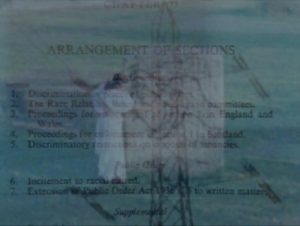
WADING ON THE SHORES OF THE UNCONSCIOUS: EXPLORING THE ROLES OF FANTASY AND IMAGINATION IN THERAPY
Word Count: 3,182 |
Download this article
by •
001: FANTASY
with #10 – INVITATION TO LOVE: FRAGMENTED VIDEO DIARY
a video by JORGOS LOUKAKOS
The capacity for fantasy is an integral element of the therapeutic relationship. On a whole, human beings place enormous stock in the things they believe about themselves and the world around them. Often people don’t consider that perhaps their perception is flawed and that what they call fact might really be fable. Much of my therapeutic work, therefore, involves a process of unraveling the constructs and myths of perception clients have unknowingly erected, then found themselves trapped within. Time, gentle encouragement, and steady support can go a long way to helping clients perceive and experience the true futility of their unworkable fantasy-based solutions.
This brings me to the part of the mind that exerts steady power over our daily lives yet frequently goes overlooked: the unconscious. Just what is the unconscious? The unconscious is the part of our mind that exists largely outside of our everyday awareness. It’s the part that was shaped significantly by our early experiences and it has the ability to influence our judgments, feelings, and behaviors without our realization. As the repository of all our accumulated knowledge, learning, and memories, it’s why you can tie your shoes without thinking, easily remember the lyrics of your favorite song from twenty years ago, and it’s also why people often become more and more like their parents as they age (perhaps much to their chagrin). Moreover, the unconscious is also the seat of a great deal of untapped potential and internal strength, especially when it affects our fantasies, but I’ll expand upon that later, for now, let’s loop back around.
Therapeutically, when working with fantasy so much of the process is a gentle attempt to peel back the protective layers of unconscious deception that comprise self-destructive fantasy. The mind often tends toward avoidance, after all, it feels safer than diving into our fears, shame, anger, and sadness. Evolutionarily we are wired to seek safety above all else, even if that safety is only from the fear of being emotionally exposed. So many clients wish for quick fixes and easy solutions; without realizing their fallacy they both seek and expect the easy road to be the road out of suffering. I remember the distinct timbre of incredulous disappointment in a client’s voice as she exclaimed, “Wait, so these pills won’t completely eliminate my anxiety?!” “No,” I tentatively responded, “but within a few weeks they’ll likely lower it to the point where you’re able to work through what you’re feeling without becoming completely overwhelmed.” What a let-down that revelation was. In the throes of unconscious extremes, other clients have been known to tumble into the dangerous and diametrically opposed abysses of either worthlessness or self-aggrandizement. Without a thought, they compare themselves to others with tiered and inaccurately extreme quality judgments. Once one client exclaimed, “I’m such a loser. I mean look at me, I’m so depressed I lost my job and my sister is a rich corporate CFO.” He paused and started up again before I could interject, “But I’m not as big a loser as my neighbor who’s an alcoholic! I might be depressed but I never drink!”
When we fall prey to these illusions of the extreme, the inner landscape transforms into one of angels or devils, good and bad, right and wrong. This is an intra-psychic playground for the haves and the have-nots within. Down the rabbit hole, the mind tumbles, and the myriad complexity of the self is diminished in favor of unattainable perfection fueled by the sheer terror of imperfection—it’s a desperate quest to be “good” gone terribly awry.
However, there’s a flip side to all this chaos and tendency toward fantasy. The ability to construct illusions about ourselves is at times a necessary mechanism for psychological self-preservation. It’s part of what gives humanity resilience and the ability to endure awful circumstances. When confronted with horrible truths about the nature of our reality, inexplicable losses, or profoundly traumatic experiences, our minds will often cleave the facts from our conscious awareness and scuttle them off to dark corners of our unconscious so that self—the conscious, day to day functioning self—can continue on with the business of life. This disconnection serves as a necessary and protective illusion. It operates in the client whose father died when she was seventeen. Confusingly, she never cried or experienced any concrete sadness despite the power of their bond. At thirty-eight she’s now struggling with panic attacks, depression, and a morbid fear of death, wakes, and funerals. It operates in the eight-year-old child who survived a serious car accident, though his brother didn’t. Since the accident, he behaves well at home and at school. His expression of grief was minimal, but he now nightly wets the bed and is prone to extended bouts of unshakeable silence.
The strategy of psychological disconnection in response to trauma works up to a point; the problem arises when it no longer functions smoothly. When we grow anxious, angry, and sad, when we begin to feel worthless, hopeless, and terrified of life itself, the fantasy of disconnection as a workable solution has failed. These kinds of psychological disruptions are the mind’s desperate attempt to re-establish the integration of difficult experiences that have been banished to the unconscious and forgotten by the conscious mind. To disconnect from the fluid whole that comprises the link between the conscious and unconscious minds creates an internal schism, and the self is always attempting to move toward wholeness and integration.
I think now of a client we’ll call Mona. Mona was a slender, delicately featured 27-year-old woman who was struggling with severe depression and anxiety. She worked in a local grocery store stocking shelves, but with minimal social life, no romantic prospects in the last few years, and a bachelor’s degree in biochemistry with lingering dreams of graduate school, she felt she was living far beneath her potential. In session, she was deeply eloquent and insightful, but her languid hazel eyes held a perpetual look of terror. It was as if simply by speaking to me she risked experiencing emotions that could toss her into an inescapable abyss. Orphaned by a snowy car accident at age six, she was now the financially supportive niece of an aunt who’d been disabled for the last decade, and she was coming to the end of her proverbial rope. One session she confessed, “I can’t take it anymore. I feel like I’m cracking. I can’t take the anger. The resentment. The guilt—because I’m the good niece, the responsible niece, the only god damned niece there is—but I’m not supposed to feel these things. That makes me bad. And I’m good, not bad . . . but I’m done, I’m done with all of it. I’m done with pretending I’m perfect because I’m not. I’m a mess and I hurt and I’m detached! I hate my hurt and even more, I hate that I’ve been hurt. I’m so lonely and cut off and I so desperately want authenticity, an authentic self, and an authentic love . . . but that feels ridiculous.”
This felt like a big moment, so I paused briefly, then softly asked,
“It feels ridiculous to want authenticity and connection?”
“Well, yeah, kind of.” This time she paused, looked at the floor, then peered up at me and urgently said, “I want my heart back. I feel so fake, and I don’t want to be fake. I want my heart, my love, my joy, my passion, my personality, and my identity. I want to be real because I don’t want to be lonely anymore.”
Mona’s disconnection from her past pain was separating her from life itself, and this was compounded by her disgust for her own suffering. She longed for connection, but to find her connection first meant wading through the forgotten pain and suffering that was cutting her off from her core.
However, part of her dilemma was that in the past her ability to shut out her suffering represented a power that she idealized. At one point she declared, “I don’t want all the pain. It means I’m stupid, vulnerable, weak, whatever. Because I’m strong.” After she said this, her voice got quiet and dejected, “And that’s the problem. It’s thinking like this that’s the mistake. I know it’s not healthy, but I think it’s what’s kept me going. It’s served its purpose.” To be in control and disconnected from herself was her temporary fantasy-based solution that had now become a prison for her mind. She was stagnating personally and professionally, and she went through her days in a state of intense psychological suffering that vacillated between numbness, anxiety, and despair.
So what can we do for clients like Mona who struggle with elusive fantasies of the sustainability of emotion disconnection? With any client so much depends on the severity of their psychological symptoms, the level of their insight, and their willingness as well as their motivation to change. Change is hard and growth is uncomfortable, whereas fantasy has a soothingly addictive quality (at least in the short term). Fantasy is larger than life; for those who swing between internal emptiness and excess, the excesses of illusion may seem the only viable option for one to feel alive. But for clients who are in a mental space where they are ready and able to enact lasting change and who are willing to uncover their fallacious fantasies, mobilizing their imagination—the very source of their fantasies—can help clients move towards powerful, lasting psychological growth and healing.
So much of what drove Mona’s transformation was her ability to utilize her imagination. Our minds are creative machines. What we emotionally experience in our inner world can become a veritable reality in our minds. And the unconscious, despite its elusive nature, contains legions of untapped potential and internal resources. Its language and currency are narratives, images, symbols, and emotional landscapes, and what better method to use than hypnotic guided imagery to access this ephemeral realm of the mind, which is exactly what we did.
However, hypnosis has received a lot of bad press over the years. The reactions I’ve received to this methodology vacillate between fear, incredulity, and outright disbelief that I would use something so hokey and “woo woo” in my practice. I find this mischaracterization quite tragic due to hypnotherapy’s profound potential for clinical effectiveness. This is not a quick fix, nor is it mind control. Rather, used clinically in conjunction with talk therapy, over an extended amount of time, hypnotic guided imagery functions as a gentle but incisive tool to access and reintegrate an imaginal and emotional part of the self that has been locked away and forgotten.
However, I’m not referring to memory recovery, where a hypnotherapist has a person recall and/or relive their past in intricate detail. I don’t believe that reliving the past is absolutely necessary for healing. Rather, I’ve found that re-experiencing a part of the self that was wounded can lead to a reintegration of the psyche, which eases and abates painful psychological symptoms. So this was what Mona and I did.
Since so much of her disconnected pain originated in childhood, beginning with the tragic loss of her parents and the feeling of having to grow up too quickly because of her aunt’s disability, we collaboratively chose to help her reconnect with her inner child using guided imagery and hypnosis. Our sessions began with gentle grounding exercises. I would instruct her to get comfortable in her chair then guide her through feeling into the different parts of her body beginning at her feet and ending at the crown of her head. After attaining relaxation I took her on a visual/psycho-kinesthetic journey within to a place of peace and natural beauty. She chose a lush mountain top forest with a gently flowing stream cutting through it. I then included the suggestion that if at any time during our session she felt overwhelmed she could return to this place of safety by pressing her index finger and thumb together—which I had her do during the entirety of her imaginal time in her place of peace and beauty. Before delving into her childhood pain I instructed her, “You know when you are, which is right now. You’re an adult, existing in the present day and you know that your mind is vast and encompasses many eras of the self, but even when you look to the past, some part of your mind will always remain here in the present, securely anchored in the understanding you have of yourself, and this present self will be able to compassionately view your past selves as connected and separate at the same time. Always knowing that if you feel overwhelmed all you need to do is press your index finger and thumb together and you will feel awash with peace and safety once again anchored always in the safety of your present self.” (The language I use is purposely filled with excessive “and’s” and run on sentences to keep the flow unceasing.) I then moved toward encouraging Mona to imagine what she looked like as a young child using an image from a photo she’d found at home. Rather than summoning any kind of specific memory, I directed her to seek out her emotions of hurt, loss, and sadness. To dig in emotionally the way we’d already been doing outside of hypnosis for weeks now. I encouraged her to work on connecting compassionately her separate adult consciousness to the imagined child consciousness within. Using visualization I suggested Mona picture her adult self alongside her child self and that the adult connect with the emotions it was feeling in relation to the child. All throughout the process Mona was fully aware and communicating with me sharing her emotions and impressions. Hypnosis does not require a person to go “unconscious,” but rather it’s a honing and focusing of our consciousness’s imaginal fantasy producing mechanism that can be used therapeutically to get in touch with deep aspects of the self.
After our first session, once out of the hypnotic state, Mona admitted that influx of new feeling was initially terrifying; it was unfamiliar and she feared it might obliterate her. But in the spirit of willingness, Mona was taking the risk. She was also using the imagery of the place of peace and beauty on her own, which helped to lower her anxiety outside of our sessions. All in all her openness to experiencing what her mind falsely presented as destruction was largely in part what gave her the ability to be with her internal emotional reality in a more receptive, compassionate, and integrated way. This process repeated over several months, with different layers of emotion and reflection uncovered throughout the process, and in time this newfound sense of internal connection led to an increasing sense of relief for Mona. She began to go out more and began dating again. She started looking up graduate schools for biochemistry and, perhaps most importantly, she realized that she could go into her own pain and come out of it. In one of our final sessions, we shared this exchange when talking about her newfound ability to experience a broadened range of emotion:
“It’s crazy to realize, but what I feel, it’s not right, it’s not wrong, it just is. Whatever I feel just is. What a weird space to be. I’ve always been so fixed on being right or wrong. This is progress, right? This is evolution and discovery? God, I hope so. I don’t even want to feel better, I want to feel alive.”
“This is progress, you’re beginning to feel differently.” She looked at me with his eyes shining as she said,
“Yeah, I feel differently, even though it’s awful sometimes it feels better to feel different, to feel something, to feel more. I realize there’s so much to discover and I don’t have to stop. It’s scary, but sometimes it even feels good . . . and that’s, that’s unbelievable, hell it’s exciting!”
For clients who have a lot of emotional fragmentation and struggle with the fantasy that this is a long-term psychological solution, I’ve found the energetic release of experiencing powerful, locked away emotion has the unique capacity to mobilize the creative forces within them. It allows them to expand beyond who they’ve been into who they always suspected they could become. It’s as if ignored emotion had hardened inside them and trapped the will to act freely in the world, so, freeing the emotional self allows clients to reorient their minds away from the dangerous extremes of fantasy toward a center that is more moderate and sustainable. Then, as we’ve seen with Mona, emotion from across the spectrum can be recognized as valid and processed, rather than turned away upon recognition.
All in all, fantasy in the context of therapy has many expressions and forms. Regardless of fantasy’s guise, the clinician’s role remains the same; our job is to provide the needed empathy and insight to assist clients in feeling safe enough and strong enough to view and discard their fantasy-based self-deceptions, which ultimately hinder them more than help. It takes time. It takes empathy. It takes patience. And perhaps most importantly, it takes a willingness to first confront the fantasies and illusions of our own.
All client names, ages, physical descriptions, dialogue, and overall identifying information have been altered to protect client confidentiality.
ELIZABETH CARTER writer
Elizabeth Carter has a Master’s of Science in Clinical Mental Health Counseling from the University of North Carolina at Greensboro. Presently, she works both online and in Zürich, CH as a private practice counselor, coach, and hypnotherapist. She originally hails from Massachusetts in the USA.
JORGOS LOUKAKOS artist
Jorgos Loukakos was born in Greece, studied (Fine Arts & Photography) and worked in Athens, Amsterdam, and Prague. Currently living in Berlin.
#10 – INVITATION TO LOVE: FRAGMENTED VIDEO DIARY combines day-to-day autobiographical images in ways that convey a cinematic experience, leading the viewer to question what separates reality from fiction. Storylines and plots are suggested but never resolved. A fragmented video diary in which each “episode” is treated as a short abstract poem during the editing process.
© Copyright for all texts published in Stillpoint Magazine are held by the authors thereof, and for all visual artworks by the visual artists thereof, effective from the year of publication. Stillpoint Magazine holds copyright to all additional images, branding, design and supplementary texts across stillpointmag.org as well as in additional social media profiles, digital platforms and print materials. All rights reserved.



